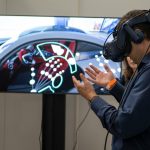Virtual reality (VR) technology has brought a revolution in the gaming industry, creating immersive and engaging experiences that captivate players. Designing user-friendly interfaces for VR puzzle games presents unique challenges and opportunities. The goal is to craft an experience that is intuitive, enjoyable, and accessible for users. In this article, we will delve into the fundamental considerations for designing these interfaces, highlighting the essential elements that enhance the player experience.
Understanding the User Experience in VR Puzzle Games
When designing interfaces for VR puzzle games, you must prioritize the user experience. VR offers a unique level of immersion that traditional gaming platforms cannot match. This immersion can significantly enhance or detract from the gaming experience based on how well the interface is designed.
Also read : What are the best practices for implementing adaptive lighting conditions in horror VR games?
The user experience in VR puzzle games is all about interaction. Players should feel as though they are part of the virtual world, fully engaged in solving puzzles. To achieve this, the design must be intuitive and responsive, ensuring that the players can easily navigate through the game without feeling frustrated.
Immersion is a crucial aspect here. The more a player feels submerged in the virtual environment, the more enjoyable the game will be. This requires thoughtful design that takes into account the sensory experiences associated with VR. Sounds, visuals, and even haptic feedback play a role in creating a seamless and engaging user experience.
Also read : How can developers ensure accurate simulation of microgravity in space adventure games?
Key Elements of a User-Centric VR Puzzle Game Interface
- Intuitive Navigation: Users should find it easy to move around in the virtual space. Clear visual cues and natural movement options (such as head-tracking) can help achieve this.
- Responsive Controls: The interface should respond promptly to user actions. Delays can break the immersion and frustrate players.
- Consistent Feedback: Provide immediate feedback for user actions to keep them informed and engaged. This can include visual, auditory, or haptic feedback.
- Minimalistic Design: Avoid cluttering the interface with too many elements. A clean, minimalistic design helps players focus on the puzzles without unnecessary distractions.
- Accessibility: Ensure the interface is accessible to all users, including those with disabilities. This can involve adjustable difficulty levels, customizable controls, and options for different sensory inputs.
By focusing on these key elements, you can create a VR puzzle game that offers a compelling and enjoyable user experience.
The Role of Immersion in VR Puzzle Game Design
Immersion is the cornerstone of any VR experience, and VR puzzle games are no exception. When players are deeply immersed in the virtual world, they become more engaged with the puzzles and the overall game. This immersion is achieved through a combination of visual, auditory, and tactile elements, all working together to create a cohesive experience.
To achieve high levels of immersion, consider the following factors:
Visual Design
The visual design of a VR puzzle game should be both appealing and functional. High-quality graphics and realistic environments can help draw players into the game. However, it’s not just about how the game looks; it’s also about how the visual elements are used to guide the player.
- Environmental Cues: Use visual cues within the environment to guide players and provide hints for solving puzzles. This can include highlighted objects, pathways, or interactive elements.
- Consistency: Ensure that the visual style remains consistent throughout the game. A cohesive visual design helps maintain immersion and prevents players from being distracted by inconsistent elements.
- Lighting and Shadows: Proper lighting can enhance the sense of depth and realism in a VR environment. Use lighting and shadows to create a more immersive atmosphere and to highlight important elements.
Auditory Design
Sound plays a crucial role in creating an immersive VR experience. The right sounds can enhance the sense of presence and make the virtual world feel more real.
- Spatial Audio: Use spatial audio to create a three-dimensional soundscape. This helps players locate objects and understand their environment better.
- Sound Effects: Include sound effects that correspond to player actions and environmental interactions. For example, a click sound when a player picks up an object or a whoosh sound when they move quickly.
- Background Music: Subtle background music can set the tone and mood for the game. However, it should not be overwhelming or distracting. The music should complement the gameplay and enhance the overall experience.
Tactile Feedback
Haptic feedback can further enhance the sense of immersion by providing physical sensations that correspond to in-game actions.
- Vibration: Use vibrations to simulate physical interactions, such as picking up objects or pressing buttons. This adds a tactile dimension to the virtual experience.
- Force Feedback: More advanced haptic devices can provide force feedback, making actions like pulling levers or turning knobs feel more realistic.
By carefully considering these elements, you can create a VR puzzle game that offers a deeply immersive and engaging experience for players.
Interaction Mechanics in VR Puzzle Games
Interaction mechanics are the backbone of any VR puzzle game. These mechanics dictate how players interact with the virtual world and solve puzzles. The goal is to create an intuitive and enjoyable interaction system that keeps players engaged and challenged.
Designing Intuitive Interaction Mechanics
- Natural Gestures: Use natural gestures that mimic real-world actions. For example, players can reach out and grab objects, twist their wrists to turn knobs, or swipe to move items. This makes the interactions feel more intuitive and reduces the learning curve.
- Multi-Modal Input: Allow players to use multiple input methods, such as hand controllers, eye-tracking, and voice commands. This provides flexibility and caters to different player preferences and abilities.
- Contextual Actions: Design interactions that are context-sensitive. For example, the same gesture can have different effects depending on the current context. This reduces the number of controls players need to remember and makes the interface more intuitive.
Creating Challenging Yet Fair Puzzles
- Progressive Difficulty: Start with simple puzzles and gradually increase the difficulty. This helps players build confidence and learn the mechanics gradually.
- Clear Objectives: Ensure that the objectives of each puzzle are clear. Players should understand what they need to achieve, even if they don’t know how to achieve it right away.
- Provide Hints: Offer hints or guidance for players who get stuck. This can be in the form of subtle environmental cues, optional hint systems, or NPCs that provide clues.
- Avoid Frustration: Design puzzles that are challenging but fair. Avoid arbitrary or illogical solutions that can frustrate players. Ensure that there is always a clear path to solving the puzzle, even if it requires creative thinking.
Ensuring Smooth Interaction
- Low Latency: Minimize latency in all interactions. Delays can break the immersion and make interactions feel unresponsive.
- Calibration Options: Provide options for players to calibrate their input devices. This ensures that the controls are accurate and responsive for each player.
- Feedback Loops: Create feedback loops that keep players informed about their actions. This can include visual, auditory, or haptic feedback that confirms successful interactions.
By focusing on these aspects, you can create interaction mechanics that are both intuitive and engaging, enhancing the overall user experience in your VR puzzle game.
The Importance of Testing and Iteration in VR Game Development
The development of a VR puzzle game doesn’t end with the initial design. Testing and iteration are crucial steps to ensure that the game meets the expectations of users and provides a seamless and enjoyable experience.
Conducting User Testing
- Diverse Testers: Involve a diverse group of testers, including both novice and experienced players. This helps identify issues that may not be apparent to the development team.
- Real-world Scenarios: Test the game in real-world scenarios to understand how players interact with the game in different environments and conditions.
- Gather Feedback: Collect detailed feedback from testers about their experience. This can include surveys, interviews, and observation of their gameplay.
Iteration and Improvement
- Analyze Feedback: Carefully analyze the feedback from testers to identify common issues and areas for improvement.
- Make Adjustments: Use the feedback to make necessary adjustments to the design, mechanics, and interface. This can include tweaking controls, redesigning puzzles, or improving visual and auditory elements.
- Repeat Testing: Conduct multiple rounds of testing and iteration. Each iteration should bring the game closer to the desired user experience.
Continuous Improvement
- Post-launch Support: Continue to support and update the game after launch. Address any issues that players report and make improvements based on their feedback.
- Community Engagement: Engage with the player community to gather ongoing feedback and suggestions. This helps build a loyal player base and keeps the game relevant.
- Monitor Metrics: Use analytics to monitor how players interact with the game. This can provide valuable insights into areas that need improvement and help identify trends and patterns in player behavior.
By prioritizing testing and iteration, you can ensure that your VR puzzle game offers a polished and enjoyable experience for all players.
Designing user-friendly interfaces for VR puzzle games involves a careful balance of intuitive design, immersive elements, and engaging interaction mechanics. By prioritizing the user experience, focusing on immersion, and continually iterating based on user feedback, you can create a VR puzzle game that captivates and challenges players. The key is to create an environment where players feel fully immersed in the virtual world, with intuitive controls and responsive interactions that make the gameplay enjoyable and rewarding. With the right approach, you can design a VR puzzle game that stands out in the ever-evolving landscape of virtual reality gaming.






